
|
![]()
Greatest Films of the 1920s
1920 | 1921 | 1922 | 1923 | 1924 | 1925 | 1926 | 1927 | 1928 | 1929
Title Screen Film Genre(s), Title, Year, (Country), Length, Director, Description 
Alibi (1929), 83 or 91 minutes, D: Roland West
This important Best Picture nominee blended the German expressionist style of the 1920s with the American gangster melodrama, and was noted for the Art Deco sets of famed production/art designer William Cameron Menzies. It was hailed as the first expressionistic crime film. A silent version was released simultaneously with the talkie version. In the cops vs. crooks story based on the long-running Broadway 1927 play Nightstick, an ex-convict and slick prohibition gangster, Chick Williams (Chester Morris) - after being released from prison, rejoined his mob. He romanced the police chief's rebellious yet naive good-girl daughter Joan Manning (Eleanor Griffith) and married her. Her father was the gruff and determined Police Sgt. Pete Manning (Purnell B. Pratt) who had allegedly framed Chick and put him away. During a warehouse heist, Chick cold-bloodedly killed beat patrol officer O'Brien (DeWitt Jennings), and used his wife's alibi to escape prosecution. During the investigation of the case, Chick also murdered undercover cop Danny McGann (Regis Toomey) posing as a perpetually-drunk Wall Street broker, leading to his lengthy death scene. Both sides of the law were portrayed as corrupt and lacked a moral center.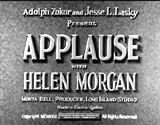



Applause (1929), 80 minutes, D: Rouben Mamoulian
Rouben Mamoulian's first film (and first feature-length sound film), a backstage musical tragedy, did creative and revolutionary things with recorded sound. The talkie was a liberating, innovative breakthrough film at a time of 'static' and stultified film-making with bulky immobile cameras on sound stages. He introduced revolutionary camera techniques (including rhythmically moving and inventive shots, and the use of two cameras at the same time) and experiments with sound (use of overlapping or interlacing soundtracks, sound cues, auditory montages, and background noise). Also it had interesting, unusual, and revolutionary camera angles (from above and below) including a triangulated shot showing two simultaneous actions, the first innovative use of background sound, and it was the first film made with a two-channel or two-track monophonic mix. The film's main theme was to provide a realistic and cynical look at seamy backstage life. Kitty Darling (real-life torch singer Helen Morgan) was introduced as a voluptuous, 1920s Broadway and nightclub burlesque ("strip and tease") singing star. The chorus line of cheap-looking burlesque dancers in the Zenith Opera House was composed of unattractive, pudgy, fat-legged and washed-up, middle-aged chorines wearing wrinkled white tights, rather than conventional cute blondes. After giving birth to a daughter named April in her dressing room, Kitty also learned through a telegram that her husband had been executed for murder. She was horrified that now, she was a single mother. With advice from Joe King (Jack Cameron), one of the burlesque clowns and also her suitor, the self-sacrificing Kitty was determined to save her young 5 year-old daughter April from more experienced and manipulative characters, by sending her away to be convent-raised and sheltered. Years later when April (Joan Peers as adult) was 17 years old, Kitty had become a fading, boozing, aged and "washed-up" performer. Kitty sang the plaintive What Wouldn't I Do For That Man to a photograph of her latest boyfriend-lover - the unscrupulous, predatory, unfaithful, belittling and brutish "Bad Boy" lover and burlesque comic Hitch Nelson (Fuller Mellish, Jr.) - it was obvious that he was a two-timing cheat (and was only spending her money), as he kissed another burlesque chorine down the hall - in a triangulated split-screen view. Kitty married him to appear respectable to April. Hitch demanded that April return home from the convent, and made the sinister promise: "We'll be one big happy family." After leaving the convent, April was thoroughly embarrassed, shocked, and repulsed when she saw her mother onstage during a burlesque show and heard leering male audience spectators calling her 'washed-up.' She also found herself the victim of Hitch's groping, unwanted kisses, and his efforts to have her enter into the seamy and sleazy world of burlesque and sexual promiscuity. April pleaded with her mother: "Let's go away from here." One night when April was walking on the street and receiving unwelcome come-ons from men, a lonely sailor-suitor Tony (Henry Wadsworth) from Wisconsin shielded her, and they went on an all-night dinner date - and ended up sitting on a Brooklyn bridge steel girder; they concluded their date with their 'first love' kiss. Their next date was also high atop a skyscraper while overlooking the New York buildings and sights below. The young couple made plans to marry each other, but April called it off due to her despondency regarding her mother. She had overheard Hitch calling Kitty a washed-up fat old woman, who would have to live off April's earnings. Feeling guilty, April decided to join the burlesque show chorus line to financially help to support her mother. In a disturbing and heartbreaking sequence, April reluctantly said goodbye to Tony at a restaurant and at the subway - she deceived him by telling him that she couldn't marry and live with him in Wisconsin due to her career plans to be a Broadway star. When April returned to her mother in the theater to tell her that she was joining the act, she saw that Kitty had suicidally poisoned herself (with an overdose of sleeping pills) and was slowly dying in her dressing room. Although despondent, she told her mother - "Nothing matters now but you, Mommy. We'll always have each other. Nothing is ever going to separate us again." She had to force herself to dance sordid burlesque (and vowed to give the crowd their 'money's worth': "I'll show them") in place of her mother, who was thought to be drunk. April performed in front of a male audience as her mother was slowly dying. Disgusted with herself, however, she soon realized that her needs were not met with audience applause. She became hysterical and ran off the stage. Tony was there to greet her and explain how he felt that she didn't really want to break up with him. They hugged and decided to go away together, embracing in front of a wall poster of a smiling Kitty. Not knowing that her mother had already passed away, April added that they also needed to take care of her mother, and Tony agreed.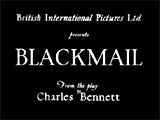


Blackmail (1929, UK), 96 minutes, D: Alfred Hitchcock
This was Hitchcock's first sound film (and the UK's first full-length talking picture) - although it was originally made as a silent picture (and simultaneously as a sound film) - with some vocal dubbing. It featured one of the director's earliest cameo appearances - a custom that would become a regular feature of his films (and the films of many others). Young and flirtatious Alice White (Anny Ondra), the daughter of a tobacco shopkeeper in 1920's London, killed over-zealous admirer Mr. Crewe (Cyril Ritchard) with a large bread knife when he sexually assaulted her in his artist's attic studio. She became guilt-ridden and fearful as her boyfriend Frank Webber (John Longden), an up-and-coming detective at Scotland Yard, pursued the case (and knew she was the assailant after finding her glove at the scene) - while blackmail was threatened by opportunistic wanted criminal Tracy (Donald Calthrop). Alice and Frank schemed to pin the rap on the blackmailer, and the film concluded with a suspenseful, climactic chase sequence after Tracy in the British Museum.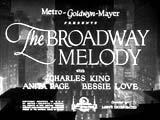



The Broadway Melody (1929), 104 minutes, D: Harry Beaumont
This was MGM's first full-length, original (backstage) musical feature, advertised as "all-talking, all-singing, all dancing." It was the first, widely-distributed sound film and first musical (with an original score) to win an Oscar for Best Picture (or Best Production) for 1928-9. The motion picture signaled that with the coming of sound films, the musical film genre was born, and that live stage musicals as an art form were threatened. This film was used as the model for all future backstage film musicals - a series of Broadway Melody sequels followed that stretched out to 1940 (the final film starred Fred Astaire and Eleanor Powell). The films included: Broadway Melody of 1936 (1935), Broadway Melody of 1938 (1937), and Broadway Melody of 1940 (1940). This film was about the romantic adventures of two sisters from the Midwestern "sticks: the older, more energetic and business-smart Harriet "Hank" (Bessie Love) and her grown up younger and pretty blonde sister Queenie (Anita Page) - a song-and-dance vaudeville team known for their sister act as "The Mahoney Sisters" who were searching for stardom on Broadway. Housed in a theatrical hotel on 46th Street in NYC, the two sisters were being promoted as performers by amorous song-and-dance man and songwriter Eddie Kearns (Charles King). Eddie had summoned his home-town girlfriend Hank and her formerly-overlooked-sister to the city to audition for a revue ("Zanfield's Dollies") that included his latest song ("Broadway Melody"), being produced by famed Broadway producer Francis Zanfield (Eddie Kane) (an obvious takeoff on Flo Ziegfeld). A love triangle developed between "Hank", Queenie, and Eddie, and although "Hank" was engaged to be married to Eddie, Eddie began to fall in love with Queenie, who didn't want to hurt her older sister's feelings. After auditions, Queenie (due to her beauty) was selected to fill a slot in the revue for one of the injured showgirls, and she was soon to be seduced by the wealth of the notorious, mean and selfish playboy Mr. Jacques "Jock" Warriner (Kenneth Thompson) (an obvious takeoff on Jack Warner), and both Eddie and "Hank" became worried for her. A second love triangle developed, between Queenie, Eddie, and "Jock." Although Queenie was paired with the dishonorable "Jock" and acted as if she had been bought off, she still retained strong feelings for Eddie. Eventually, Eddie and Queenie confessed their love for each other ("You Were Meant For Me"), but then, Queenie returned to "Jock" to save her sister from heartbreak. When "Hank" realized her sister's love for Eddie, she berated him and then released her claim on him ("I wouldn’t marry you if you were the last man on Earth!"), urged him to fight for Queenie ("You're a coward! You're afraid of Jacques Warriner! Or, you'd go out and fight for her! But, you're just yella!"), and asserted that she had only used Eddie for career advancement into the revue. In a highly emotional, self-sacrificial scene, "Hank" revealed her upset and depth of character, intermittently both sobbing and laughing. Eddie pursued "Jock" to the Park Avenue apartment that the lothario had bought for Queenie (along with providing her with a diamond bracelet, a fur coat and a Rolls Royce), and physically confronted "Jock" - to defend Queenie from "Jock's" unwanted advances. After being socked in the face, Eddie left with her, and Queenie and Eddie were subsequently married. Queenie announced an end to her show-business career, so she could settle down on Long Island in a new home. She invited her sister "Hank" to live with them, but "Hank" had other plans with a new cheap blonde chorus girl partner Flo (Mary Doran), and vowed to be on the Broadway stage within six months after touring out West. With memorable songs including "Give My Regards to Broadway," "You Were Meant For Me," and "Wedding of the Painted Doll" (originally shot in two-strip Technicolor), beginning a trend for other musicals to include color sequences.


Un Chien Andalou (1929, Fr.) (aka An Andalusian Dog), 16 minutes, D: Luis Bunuel
This shocking, and provocative surrealistic film (one of the first) of the 1920s avant-garde movement, only about 16 minutes long, was filled with irrational, freely-associated and shocking images without any sense of logical continuity or narrative. It was banned in various countries, mostly for its infamous eyeball razor-slashing scene in the opening. After a title card reading: "Once upon a time," a middle-aged "husband" (Luis Buñuel) sharpened his razor and then held his "wife" (Simone Mareuil) as he slit her eye with the cutting instrument. [Note: a dead calf's eye was cut in the scene.] The sequence was intercut with shots, viewed from the balcony, of the full moon as it was sliced or bisected by clouds. Other shocking elements: the image of ants coming out of a hole in a man's hand, the dismembered hand lying in the street, and a decomposed horse on a grand piano.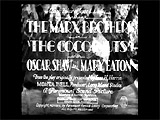

The Cocoanuts (1929), 93 minutes, D: Robert Florey & Joseph Santley
Advertised as Paramount's All Talking-Singing Musical Comedy Hit! And it was the feature film debut of the zany Marx Brothers, filmed at the Astoria studios on Long Island. It featured music and lyrics by Irving Berlin and was one of the earliest successful talkie films. It was noted as the film with the first overhead camera shot, often repeated as kaleidoscopic patterns in Busby Berkeley's musicals in the near future. The film was based on the Marx Bros.' 1925 stage hit by George S. Kaufman and scripted by Morrie Ryskind. In the 1920s, leering and corrupt real estate salesman Mr. Hammer (Groucho Marx) owned and managed a struggling, basically vacant beach-front resort Hotel de Cocoanut with his conservative assistant Jamison (Zeppo Marx). In the plot, scheming, unethical socialite Penelope Martin (Kay Francis) proposed to glum partner-in-crime, socially-prominent, in-debt cad Harvey Yates (Cyril Ring) that they could make millions if he was unable to marry rich ingenue Polly Potter (Mary Eaton), the daughter of wealthy socialite widow Mrs. Potter (Margaret Dumont - Groucho's favorite foil), the hotel's sole paying guest. If Harvey could acquire Mrs. Potter's key, Penelope would sneak into Mrs. Potter's hotel room (next to hers in Room #320 through a connecting, unlocked doorway) and steal her expensive diamond necklace locked in her dresser. Instead of being interested in Harvey, Polly insisted on being with Bob Adams (Oscar Shaw), a lowly aspiring architect who worked at the hotel as a clerk. Bob told his girlfriend Polly that he had dreams of developing a nearby area of land and calling it Cocoanut Manor. Mrs. Potter was being conned and courted by fast-talking Hammer to acquire her money, and to fleece speculators by auctioning off Florida 'swamp land' in the Cocoanut Manor area. Two freeloaders arrived in the lobby: Harpo (Harpo Marx, a harp and clarinet player), who appeared with a honking walking stick-cane, and Italian Chico (piano-playing Chico Marx). The two proceeded to cause havoc in the hotel. The plot hinged on Hammer's Florida real-estate development scheme and the theft-recovery of Mrs. Potter's valuable stolen necklace, but those plotlines were less significant than the wisecracks and antics of the Marx Brothers, including some classic scenes (the rigged auction scene and the "Why a Duck?" (or viaduct) routine). In the final scene, after Bob was framed for the robbery, Mrs. Potter insisted that her daughter Polly marry Harvey. During their wedding announcement party and dinner, Polly incriminated Harvey for drawing a map to Cocoanut Manor's tree stump where the jewels had been hidden and discovered, since his handwriting matched an engagement note he had also written to her. The crooked Yates fled from the party as legitimate land tycoon John W. Berryman arrived. He offered to purchase Bob's design plans for Cocoanut Manor, and asked Hammer if he could accommodate 400 guests for the weekend. The three Marx Bros' fled from the scene. Mrs. Potter apologized and announced a change in the proceedings - her daughter would now be marrying bridegroom Robert Adams; nearby, two new handcuffed prisoners were Yates and Penelope.

Coquette (1929), 76 minutes, D: Sam Taylor
Silent star Mary Pickford (Best Actress winner for her first talkie, and the first talkie winner of an Academy Award) revamped her screen persona as a goody-goody - creating a pattern for women's films in the future. Set in the American South, Pickford took the role of Southern belle Norma Besant, a flirtatious college girl, and daughter of wealthy Southern doctor John Besant (John St. Polis). She was romantically involved with hot-tempered Michael Jeffery (Johnny Mack Brown) - compromised according to her father because he was a man beneath her social status. To prove himself, Michael left for six months to earn a living, but returned early. Dr. Besant confronted Michael and shot him to death, witnessed by Norma who faced a difficult choice - tell the truth, or save her father by lying. In the climactic courtroom scene, Dr. Besant implored the judge to ignore his tormented daughter's perjured testimony, confessed his murderous deed, and shot himself to death. The melodramatic film - and Pickford's Academy Award win for her overwrought performance (and strange accent) have been appropriately ridiculed, and shortly after a few more films, she was retired from film-making.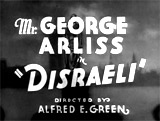

Disraeli (1929), 87/90 minutes, D: Alfred E. Green
An historical, stage-bound and stiff biopic about the British prime minister (of Jewish descent) Benjamin Disraeli (Best Actor winning George Arliss in his talkie film debut) of the 1860s-70s, and leader of the Conservative party of British Tories, who outwitted the Russians in a struggle over the purchase of the Suez Canal from Egypt, and prevented their access to British India. During the time of Victorian England, the politically-shrewd, scheming, skillful and tricky Disraeli led efforts to expand colonial policies and imperialist ventures. The historical film (though fictionalized and not entirely accurate) was previously produced as a silent film earlier in the decade as Disraeli (1921), also starring George Arliss.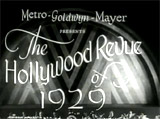
The Hollywood Revue of 1929 (1929), 118/130 minutes, D: Charles Reisner
Advertised as having 25 of the screen's greatest stars - a chorus of 200 - an amazingly revolutionary motion picture! This cinematic artifact was a box-office hit and Best Picture nominee. The lavish, star-studded musical comedy revue show was hosted by two Master of Ceremonies: Hollywood's Conrad Nagel, and Broadway's 'wise-guy' Jack Benny. They introduced MGM's silent film stars (and some Broadway personalities), performing skits, songs, and dance numbers. Highlights included Cliff Edwards singing the signature tune: "Singin' in the Rain," Joan Crawford in a jazz number, comedy from Laurel and Hardy and Buster Keaton, and others including Bessie Love, Marion Davies, and Marie Dressler. Norma Shearer and John Gilbert performed the balcony scene from "Romeo and Juliet," and one fantastic musical production number was "Lon Chaney Will Get You if You Don't Watch Out."


The Love Parade (1929), D: Ernst Lubitsch
Lubitsch's first talkie-sound film (adapted from the little-known Hungarian play The Prince Consort), was the first filmic musical. The witty and bubbly film, a fashionable operetta, exhibited the director's creative adaptation to the requirements of sound film, and was one of the first backstage musicals with musical numbers that were integral to the plot. Smoothly directed, Lubitsch avoided making it stage-bound and over-acted like many of the early talkies. The film featured the delightful pairing of singer Jeanette MacDonald (in her first film, debuting as the frustrated, red-haired Queen Louise of the never-never land of Sylvania) and the film's sole star Maurice Chevalier, a French cabaret performer in his second sound picture (as womanizing military attache Count Alfred Renard and MacDonald's consort/prince). The couple were married although unhappily with his powerless role as spouse. He was persuaded not to divorce, and the couple eventually learned to compromise. This film combined Lubitsch's sophisticated touch, sexual innuendo, songs integrated into the storyline, and such delightful and lilting numbers as "Dream Lover" (sung by MacDonald as she drowsily awakened in a sleekly revealing negligee once more without a man), their duet of the title song "My Love Parade," and Chevalier's entertaining singing of "Anything to Please the Queen." He also sang "Nobody's Using It Now" (about his tribulations after being married and finding himself virtually castrated as the Prince Consort). It received six Academy Award nominations.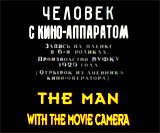


The Man With a Movie Camera (1929, Soviet Union) (aka Chelovek S Kinoapparatom, or Человек C Kино-Aппаратом), 68 minutes, D: Dziga Vertov
Soviet writer/director Dziga Vertov's masterpiece was a quintessential experimental, avante-garde film and an excellent example of a "city symphony" documentary. It was regarded as "pure" visual cinema of everyday life without a plot, action, setting or dialogue (or intertitles) - it was literally a day in the life of the Soviet Union (although filmed over a four-year period), shot with the camera slung over the photographer's shoulder. Its views of Moscow, Kiev, Odessa and of Soviet workers and machines contained radical hyper-editing techniques, variable camera speeds, dissolves, special visual effects, wild juxtapositions of images, freeze frames, split-screens, and super-imposed double exposures.




Pandora's Box (1929, Germ.) (aka Die Büchse der Pandora), 97 minutes, D: Georg W. Pabst
G.W. Pabst's classic silent film melodrama, an early erotic and hypnotic work, produced hateful critical reviews for its overt sexuality. Throughout the film, Louise Brooks portrayed a tempting goddess named Lulu. She was an insatiable, free-spirited, 18 year-old cabaret chorus girl and femme fatale with a black bob (pageboy) haircut. She was caught backstage in a wardrobe room scandalously kissing her obsessed and spell-bound patron - a wealthy newspaper owner named Dr. Ludwig Schon (Fritz Kortner) - by his more socially-acceptable fiancee Charlotte Marie Adelaide (Daisy d'Ora). During Dr. Schon's subsequent wedding party, virginally white-dressed (inappropriately), bi-sexual and amoral bride Lulu engaged in an intimate, flirtatious tango with black silken-dressed, chic lesbian aristocrat Countess Anna Geschwitz (Alice Roberts). After the ceremony and party, bridegroom Dr. Schon became enraged with jealousy at Lulu (for her starry-eyed flirtations with his son Alwa (Franz Lederer)) and thrust a gun at her, crying: "Take it! Kill yourself!...so that you don't drive me to murder as well." He was accidentally murdered during a struggle for the gun between them. During the subsequent trial for manslaughter, the hedonistic Lulu (wearing a black veil) was accused by the prosecutor of being like a Pandora's box of evil. She met her destiny during the expressionistic finale on Christmas Eve as London Soho prostitute Lulu became another gleaming-knifed victim of Jack the Ripper (Gustav Diessl) during an erotic embrace and kiss (her hand went limp to indicate her death) - after the knifeblade was stuck into her stomach - off-screen.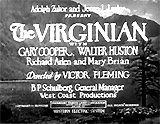

The Virginian (1929), 95 minutes, D: Victor Fleming
A western film and adaptation of a pulp novel. The story of the conflict between a Wyoming ranch-hand foreman, the Virginian (Gary Cooper) and a group of outlaws who were changing brands and rustling cattle. Walter Huston played Trampas, the villainous leader of the gang, who met his end in a dusty street shootout/showdown with the Virginian. The film was most memorable for a very early scene at the bar of a saloon. Insulted by Trampas' words: "If I wanna know anything from you, I'll tell ya, you long-legged son of a ---," the Virginian (Gary Cooper) responded by quick-drawing his gun and threatening Trampas with his pistol pressed against his abdomen: "If you wanna call me that, smile." Trampas grinned: "With a gun against my belly, I-I always smile."